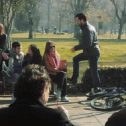"When a man dies in a traffic accident and gets into a conversation with God, he gets an answer to the biggest question of life."
Re-Entry is a short film directed by Dutch artist Ben Brand about a man who dies and gets to ask God about the meaning of life. It’s an extraordinary film in its ambition, scope and quality, and also in the fact that it’s one of those very few, counted films that have the wonderful ability to change people’s lives (as one can observe from reading comments from those who’ve watched the film).
When you put it online and get private messages from people who cried while seeing it (…) this is the highest gain you get from any film.
Re-Entry explores the idea that individual identity is an illusion, a self-deception, and provides a very positive message of joy for life, unity and hope. For those who have led a life adopting contemporary mandates of individualism and competition, the film seems to be functioning like a crash course in empathy. Adapted from a short story by US author Andy Weir, Re-Entry is a notably ambitious project for a short film, it was shot in 5 countries in 3 different continents.
The short features a crowd of characters, with two main ones, God and a man, a supernatural staging, voice-over used as narrative device and a focus on transmitting a strong meaningful message. Re-Entry deals with universal, existentialist themes that have been approached by philosophy and religion for thousands of years: life, death, identity, the afterlife and the purpose of existence. It appeals to a very wide audience and it’s easy to predict that it will stand the test of time.
Staged in the afterlife, in various locations around Earth and in outer space, the scenes are situated in the past, present and outside of time. The short focuses on growth and character development. Using dialogue to advance the story, it unfolds a Copernican shift that helps the man character realize he is not just an individual, with all the consequences that implies.
The only possible alternative is simply to keep to the immediate experience that consciousness is a singular of which the plural is unknown; that there is only one thing and that what seems to be a plurality is merely a series of different aspects of this one thing, produced by a deception
Editing is especially worth highlighting, the work done by Patrick Schonewille helps make the film shine. Complemented by music by Jesper Ankarfeldt and sound design by Mark Glynne, editing helps build moods, conflicts, contrasts and create sequences that help shape the idea of unity, by splicing together shots from different locations. It’s interesting to note the film includes play and dance sequences, two activities that permeate all human cultures. Dance is also an activity known to create social cohesion, synchronize and integrate personal identities, something which is studied in collective effervescence and crowd psychology. The remarkable performances of Issaka Sawadogo and voice-over artist Johnny Bang Reilly are worth noting, so is the impressive aesthetic camera work by Maxime Desmet, who captured some truly beautiful shots using natural lighting and provided camera moves for visual rhythm and moments of emotional displacement. The abundant use of sensory images is also worth mentioning, as they add a lot of life to the short.
It’s interesting to note that Re-Entry mixes fiction and unscripted, documentary elements. The only sequences that were artificially staged are the ones depicting the car crash and afterlife. All other scenes where intentionally captured “authentically, finding things that were actually there”, working with non-actors, according to director Ben Brand. “We wanted everything authentic and beautiful.”
Also of note, the voice of God and that of the man character were recorded by the same person, voice-over artist Johnny Bang Reilly. “It’s really interesting”, states Ben Brand, “because, in a way, they’re the same being. It really plays into the idea that the man will ultimately become a God himself.”
The film is finally premiering and screening online in a world that seems to be even more divided than ever. That’s why I hope this film can evoke even the slightest positive feeling and love for ourselves and also everyone around us.
From a sociological point of view, it’s interesting to see a film surfacing that highlights unity in an age characterized by divisiveness, cancel culture and demonization of others (be them groups or individuals). Re-Entry puts a healthy and positive focus on empathy, personal responsibility and unity. While it goes against the zeitgeist of the current age, its common sense and constructive message is one that people are notably hungry for. The story by Andy Weir that the film is based on (The Egg, 2009) is the author’s most popular short story, it has been translated into over 30 languages and has already spawned previous adaptations (into music and an animated video).
What makes Re-Entry work so well? Ben Brand and the team who worked on the film have achieved a triple feat: a successful presentation of existentialist themes in a captivating way, an excellent adaptation of a written story to the audiovisual medium, helping its message reach a much wider audience, and telling a story in a way that manages to change people’s lives for the better. There can hardly be a better compliment for a film.
A special request to readers: if you enjoyed this short, please help share it. It’s a film everyone should see. Thank you.
Director's site
Director's site
Director's site
Link
Ben Brand interview on the making of Re-Entry
Link
The Egg short story by Andy Weir
Link
Link
Link
Link
Link
Link



















Recent Comments